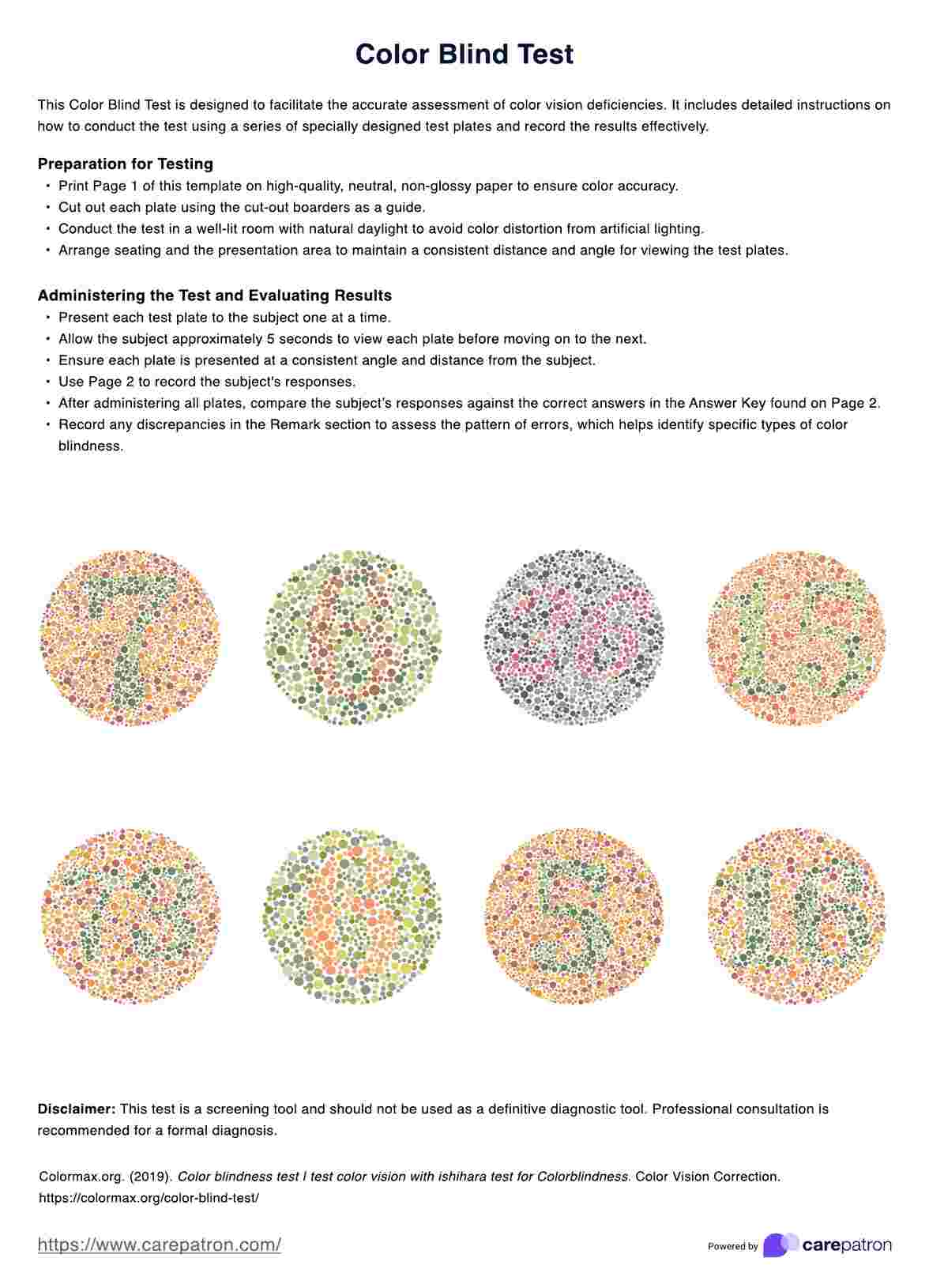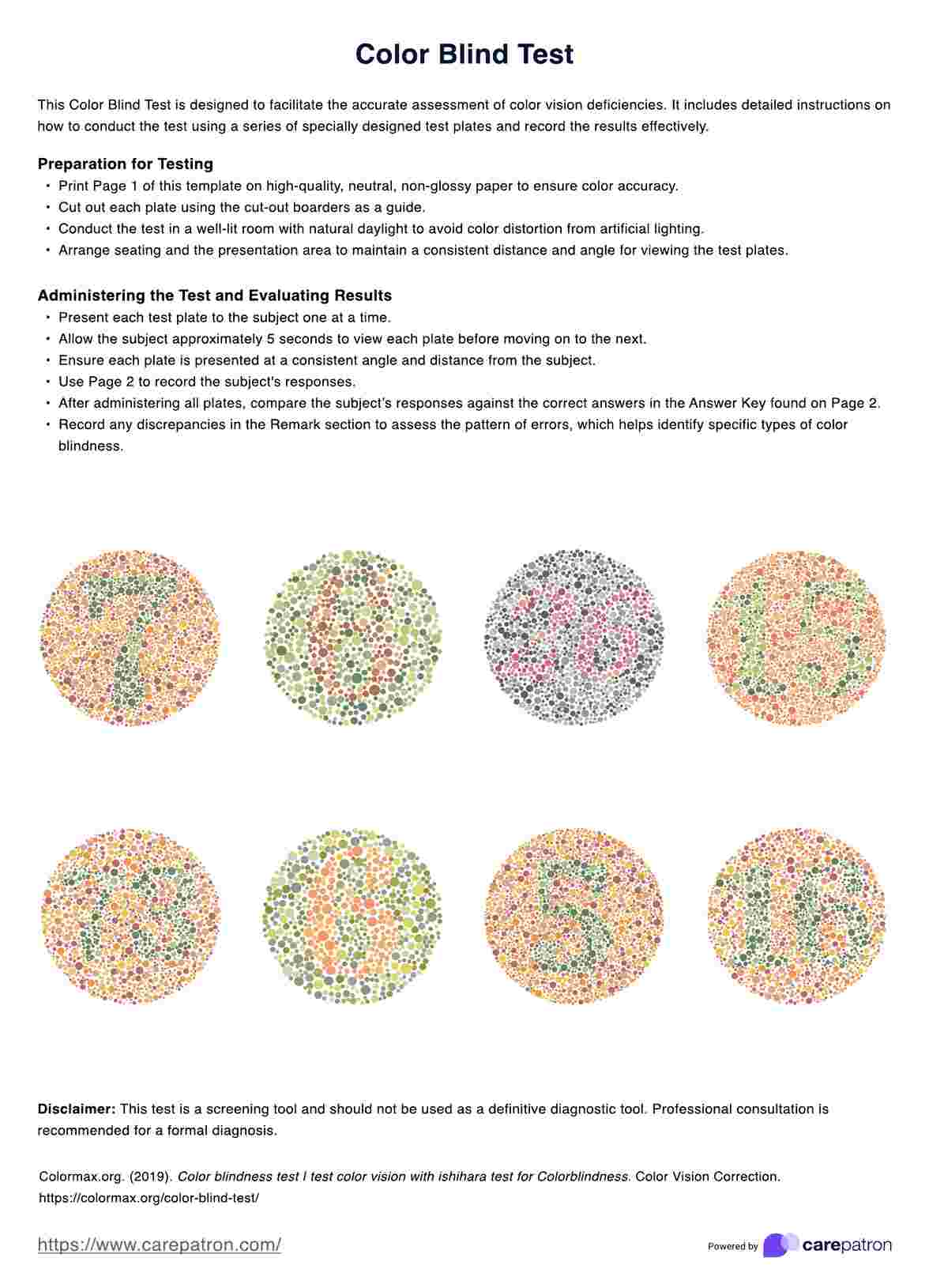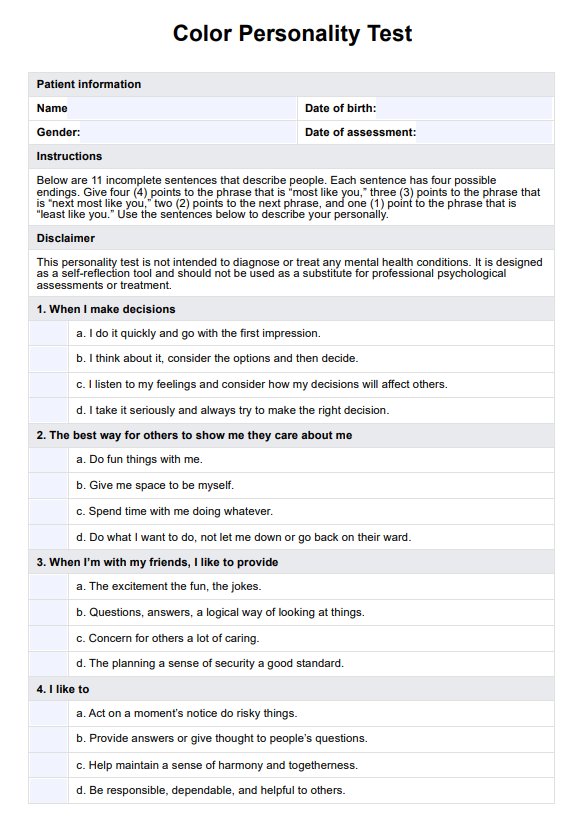Color Blind Test
Explore our comprehensive guide on Color Blind Tests: understand types, benefits, and how to use our free template for accurate color vision assessment.


What is color blindness?
Color blindness, or color vision deficiency, is a condition in which a person is unable to perceive colors in the way most people do. It typically involves difficulty distinguishing between shades of red and green or blue and yellow. The most common serious type of color blindness, red-green color blindness, affects many individuals and can influence daily activities that require color differentiation, such as reading traffic lights or choosing clothing.
Color blindness causes
Color blindness is a genetic condition passed down from parents to their children. It occurs due to defects in the cone cells of the retina, which are responsible for color vision. Other causes of color vision deficiency can include physical or chemical damage to the eye, the optic nerve, or parts of the brain that process color signals. Age-related and environmental factors can also contribute to the development of color vision deficiencies.
Color Blind Test Template
Color Blind Test Example
What is a Color Blind Test?
A Color Blind Test is a clinical tool to detect color vision deficiencies. The traditional form of this test, such as the Ishihara Color Test, involves viewing a series of specially designed plates, each containing colored dots that form numbers or shapes. Those with normal color vision see certain figures, while those with deficiencies in color spectrum either see different figures or cannot discern any figures.
How is this scored?
The scoring of a color-blind test is a direct and systematic process. Each test plate is marked with a figure or number that those with normal color vision can typically discern. As the test progresses, the participant identifies what they see on each plate. A correct identification of the figures or numbers on the plates is recorded as a positive response.
The cumulative number of correct responses is tallied at the end of the test. This total score is then used to assess the severity and type of color vision deficiency, helping to determine whether the individual has mild, moderate, or severe color blindness. This scoring system allows for a clear and quantifiable measure of an individual's color perception abilities.
The cumulative number of correct responses is tallied at the end of the test. This total score is then used to assess the severity and type of color vision deficiency, helping to determine whether the individual has mild, moderate, or severe color blindness. This scoring system allows for a clear and quantifiable measure of an individual's color perception abilities.
How to use our Color Blind Test template
Here’s how you can effectively use our printable Color Blind Test template:
- Download the template: Begin by downloading our comprehensive Color Blind Test template from our website. This resource is crafted to facilitate a streamlined assessment of color vision capabilities.
- Prepare the testing environment: Set up a well-lit area for conducting the test. Adequate lighting is essential to ensure the accuracy of the test results, as environmental lighting can significantly influence color perception.
- Administer the test: Present the test plates from the template to the test subject. Ensure that each plate is fully visible to the subject without any glare or reflection, which could skew the results.
- Record the responses: As the test subject responds to each plate, carefully note their answers. Record whether they can accurately identify and describe the shapes, numbers, or patterns shown on each test plate.
- Analyze and interpret results: After completing the test, compare the subject's responses to the correct answers in the template. This comparison will help you determine the presence and type of color vision deficiency, if any.
- Discuss next steps: If a color vision deficiency is identified, discuss the results with the test subject and recommend further evaluation if necessary. Guide how this may impact their daily activities and suggest possible adaptations to accommodate their needs.
By following these steps, you can utilize our online Color Blind Test template to conduct a thorough and effective assessment of color vision, with accurate results and providing valuable insights into the test subject’s perceptual abilities.
Benefits of taking/conducting this test
Conducting a color blindness test is crucial for identifying individuals with the more severe color blindness or vision deficiencies but also plays a significant role in mitigating challenges that may arise in daily activities, educational settings, and professional environments where normal color spectrum perception is essential. Here are the key benefits of color vision test:
Early detection and intervention
By diagnosing color vision deficiencies early, especially in young children, educational strategies can be tailored to accommodate their needs. This can include using specially designed learning materials that minimize the impact of color blindness on educational development.
Workplace adaptation
For adults, understanding color vision status can lead to necessary adjustments in the workplace, ensuring safety and efficiency. Employers can modify tasks that require color discrimination, potentially reassigning duties to fit the employee's capabilities or providing aids like color-coded tools with alternative labeling.
Informed career choices
Knowing one’s color vision status is vital for individuals considering careers in graphic design, electrical wiring, piloting, or any profession where distinguishing colors is integral to the job. Early testing allows for realistic career planning and exploration of suitable paths that don't heavily rely on color discrimination.
Enhanced personal safety
Accurate color perception is crucial for activities such as driving or operating heavy machinery. Identifying a color vision deficiency can lead to proactive measures, such as using vehicles or equipment with colored lenses or modified displays designed to accommodate color blindness.
Improved quality of life
Understanding and adapting to color vision deficiencies can significantly enhance personal and social interactions. It enables individuals to adjust their environment to reduce errors and misunderstandings due to misperceived colors.
By conducting a color-blind test, individuals gain valuable insights into color differences and their visual capabilities, enabling them to make informed decisions and adjustments in various aspects of their lives. This proactive approach can significantly mitigate the challenges associated with color vision deficiencies.
How is color blindness treated?
While there is no definitive cure for genetically inherited color blindness, there are several effective management strategies:
- Colored lenses: Specialty lenses can enhance color discrimination for individuals with certain types of color blindness, improving their ability to distinguish between colors.
- Screen adjustments: Implementing color filters and adjusting the brightness and contrast on digital screens can significantly improve visual clarity for those with color vision deficiencies.
- Visual aids: Numerous apps and digital tools are designed to help identify and label colors accurately or to alter color hues to make differences more perceptible for color-blind users.

.jpg)






































































































